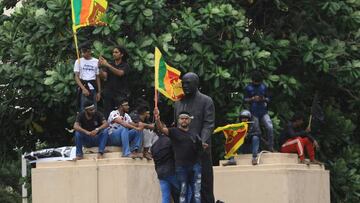Sri Lanka and the International Monetary Fund: A troubled past
Protesters have taken over the presidential palace in Sri Lanka after weeks of economic crisis and protests. Did the IMF contribute to the problems?


Just a week ago, officials from the International Monetary Fund (IMF) visited Sri Lanka after the country descended into economic chaos earlier this year. The IMF’s press release discussing the trip, ended by thanking “the authorities for the candid approach and warm hospitality and are looking forward to continuing our discussions in support of Sri Lanka and its people.” Exactly what was meant by candid remains unclear from the context. Does it mean that officials were transparent or does it mean that they were honest that the country would be taking a different strategy than that recommended by the IMF? Perhaps neither interpretation is true.
Since the visit, the political situation has shifted dramatically, with protestors taking over the presidential palace on Saturday 9 July.
Colombo, Sri Lanka right now. The Presidential Palace has been stormed, President Gotabaya Rajapaksa is said to have fled. Unbelievable scenes. Live reports on @IndiaToday: https://t.co/p6JV6FzCub pic.twitter.com/8zlJdBfN2P
— Shiv Aroor (@ShivAroor) July 9, 2022
Facing mounting pressure from other members of the government, the current President, Gotabaya Rajapaksa, has agreed to resign and leave office on 13 July 2022.
While announcing that the president would resign, Prime Minister Ranil Wickremesinghe, also said that he would be willing to leave office once a new government was formed. He took to Twitter to share this message and encourage other leaders to make the same decision.
To ensure the continuation of the Government including the safety of all citizens I accept the best recommendation of the Party Leaders today, to make way for an All-Party Government.
— Ranil Wickremesinghe (@RW_UNP) July 9, 2022
To facilitate this I will resign as Prime Minister.
Sri Lanka and the IMF
The protests that led to these changes in government came as inflation has grown over seventeen percent since the begining of the year. These historic price surges have led to food and energy shortages across the country.
Sri Lanka has fully collapsed as the Prime Minister declares the nation bankrupt.
— Wall Street Silver (@WallStreetSilv) July 9, 2022
Expect more of this in the coming months due to food and energy inflation.
🔊sound pic.twitter.com/FYwH0lFmhz
In addition to the president and prime minister, the IMF met with leaders from parliament, the Central Bank of Sri Lanka and the Secretary to the Treasury, civil society organizations, private sector actors, and development organizations.
After so many meetings, the recommendations made by the IMF are quite vague.
What policy perscriptions did the IMF recommend for Sri Lanka
After officials visited Sri Lanka a few economic recommendations surfaced:
- Reduce the elevated fiscal deficit while ensuring adequate protection for the poor and vulnerable
- Far-reaching tax reforms are urgently needed to achieve these objectives
- Containing rising levels of inflation
- Addressing the severe balance of payments pressures
- Reducing corruption vulnerabilities
- Embarking on growth-enhancing reforms.
A tighter monetary policy is likely to reduce government spending and encourage the Central Bank to increase interest rates to slow inflation. On 6 July, the Central Bank announced that interest rates would be increased by 100 basepoints, or from 14.50 percent to 15.50 percent.
Having noted the higher than expected escalation of headline inflation recently and the increased persistence of high inflation in the period ahead, the Board was of the view that a further monetary policy tightening would be necessary to contain any build-up of adverse inflation expectations
Central Bank of Sri Lanka
In most materials drafted by the IMF, the organization calls attention to the need of the government to protect vulnerbale groups as they identify ways to being the economy back under control. These issues and the approach taken to support the economic recovery, are especially concerning for some who see the current issues as a consequences of the IMF and World Bank’s structural adjustment programs in the late twentieth century.
What is strucutral adjustmnet?
Scholars, like Swarna Jayaweera, have tied the liberalization of the economy, which includes the removal of protectionist trade policies to the collapse of many domestic industries in the late 1970s. Without protectionist policies, the country was unable to make its goods more competitive for domestic consumers leading to a severe decrease in the demand for Sri Lankan goods. The second policy covered by Jayaweera was the suggestion from the IMF to establish a economic growth plan that shifited towards a focus on exports which attracted foreign investment that primarily used on cheap female labor. Cases of exploitative labor, including child labor, have also been reported within the country.
The shift to exports came after the country had applied heterodox economic strategies like import substitution industrialization which is what helped to protect their domestic industries through the use of tariffs and other protectionist policies. These policies helped to grow their economies in the 1950s, 1960s, and early 1970s. For instance, life expectancy increased hit sixty-eight and seventy-two percent for women and men, respectively, in the late 1970s. Literacy and rates of hunger also decreased during this period. Policies like import substitutional are illiberal and therefore had to be done away with after the country began receiving contingent loans form the IMF and World Bank. Now with tighter monetary policy, the state may take a number of paths, but is increase its Value-Added Tax (VAT) and other taxes while, cutting funding for welfare and social programs, and decreasing labor and environmental standards.
Some reseachers have spectualted tat these sorts of policies are on thehorizon becaues of the type loan that was begin negociated between the government (who is on its ay out) and the IMF during the most recent visit: Extended Fund Facility. These loans often coe with structural reuqirements. These reforms are called for because these loans are only offered to “countries experiencing serious payment imbalances because of structural impediments or slow growth and an inherently weak balance-of-payments position.”
These loans are are designed to “correct structural imbalances over an extended period.” So far, this type of loan has been offered to Ecuador and the government was forced to decrease the minimum wage, reduce pensions and contributions that “were deemed to be excessively generous,” and allow the governments, at all levels, to procure “infrastructure by foreign companies,” undermining the local economy.
Even before the pandemic, Sri Lanka was experiencing economic turmoil with GDP beginning to fall in 2018.
In 2015, annual GDP growth peaked, growing 12.8 percent. Those rates have not been seen since. In 2020, GDP shrank, but has since regained its pre-pandemic position. In 2019, President Rajapaksa made good on a campaign promise by cutting the value added tax (VAT), which is applied to luxury goods, from fifteen to eight percent. This was seen as a strategy to encourage growth but when the pandemic hit, the government found itself with significantly less revenue.
Finance Minister Ali Sabry, who pioneered the approach has come to see the eliminating of over seven taxes which significantly shrunk the country’s tax base as a “historic mistake.”
Related stories
Before providing any other financial support, the World Bank would like to see the financial situation stabalized.
“Until an adequate macroeconomic policy framework is in place, the World Bank does not plan to offer new financing to Sri Lanka,” read a press release that aimed to clarify the position of the Bank.